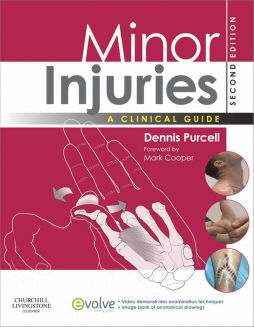
Additional Information
Book Details
Abstract
Now with a free instructional video demonstrating basic examination techniques, this second edition of Minor Injuries makes it much easier to learn procedures for assessing minor injuries. It is unique in linking the underlying anatomy to the examination processes that are part of the education of a practitioner, covering the commonly presenting injuries that, and explains how to handle them.
This text is essential for staff in accident and emergency units, minor injury units, walk-in centres and all areas where patients present with minor injuries.
Free video:
A 25-minute online video demonstrating 77 different examinations, makes them easy to understand, and covering:
The Neck and Upper Limbs
- The Shoulder
- The Elbow
- The Forearm, Wrist and Hand
The Back and Lower Limbs
- The Hip
- The Knee
- The Ankle and Foot.
Active, resisted and passive movements are shown, testing the full range of movement.
- Practical manual, with supporting video
- Demonstrates basic examination techniques
- Illustrations link anatomy with the examination processes
- Clear explanation of underlying anatomical and physiological processes behind injury
- Explains how to manage common injuries
- Accessible to the non-specialist.
- Video demonstrates basic examination processes, making them easier to learn
- Illustrations combine anatomy and examination to show how parts work and how to examine them – now with added colour
- New photographs throughout, linking to the video demonstration
- Video showing examination of every hand muscle helps master this particularly complex area
- More detail on the core clinical areas of sports injuries in children, musculoskeletal presentations, and head, neck and back injuries.
Table of Contents
| Section Title | Page | Action | Price |
|---|---|---|---|
| Front Cover | Cover | ||
| Minor Injuries | iii | ||
| Copyright Page | iv | ||
| Contents | v | ||
| Video contents | vi | ||
| Chapter 4 the Neck and Upper Limbs | vi | ||
| Chapter 5 the Back and Lower Limbs | vi | ||
| Foreword | ix | ||
| Reference | x | ||
| Preface | xi | ||
| Acknowledgements | xii | ||
| Part 1: General Issues | 1 | ||
| Chapter 1: Clinical Examination and the Written Record | 3 | ||
| Contents | 3 | ||
| What Does Clinical Mean? | 3 | ||
| The Clinical Record | 4 | ||
| The Clinical History | 5 | ||
| Recording the Examination | 8 | ||
| Chapter 2: The Injured Child | 11 | ||
| Contents | 11 | ||
| Consent and Confidentiality | 11 | ||
| Non-accidental Injury | 13 | ||
| Communication | 14 | ||
| Analgesia | 15 | ||
| Injuries to Children | 15 | ||
| Children and Sports Injuries | 17 | ||
| Part 2: Musculoskeletal Injuries | 21 | ||
| Chapter 3: Basics of Musculoskeletal Injury and Examination | 23 | ||
| Contents | 23 | ||
| Terminology | 23 | ||
| The Musculoskeletal System and Healing | 27 | ||
| Treatment of Acute Injury | 29 | ||
| Bone | 35 | ||
| Soft Connective Tissues | 41 | ||
| Basic Principles of Examination | 54 | ||
| Chapter 4: The neck and upper limbs | 67 | ||
| Contents | 67 | ||
| The neck | 67 | ||
| The shoulder | 78 | ||
| The elbow | 91 | ||
| The forearm, wrist and hand | 96 | ||
| Chapter 5: The Back and Lower Limbs | 131 | ||
| Contents | 131 | ||
| The Chest and Upper Back | 132 | ||
| The Lower Back | 135 | ||
| The Hip | 141 | ||
| The Knee | 151 | ||
| The Ankle and Foot | 159 | ||
| Part 3: Other Minor Injuries | 171 | ||
| Chapter 6: Minor Wounds and Burns | 173 | ||
| Contents | 173 | ||
| Initial Presentation With Wounds | 173 | ||
| Assessment and Exploration of Wounds | 178 | ||
| Wound Infection | 182 | ||
| Wound Treatment | 185 | ||
| Special Types of Wound | 195 | ||
| Minor Burns | 199 | ||
| Chapter 7: Minor Head Injuries | 205 | ||
| Contents | 205 | ||
| Anatomy | 205 | ||
| Minor Head Injuries and Imaging | 207 | ||
| Clinical Examination | 209 | ||
| Chapter 8: The Face | 219 | ||
| Contents | 219 | ||
| The Face | 219 | ||
| The Eye | 223 | ||
| Ear, Nose and Throat | 231 | ||
| References | 235 | ||
| Bibliography | 237 | ||
| Index | 239 |
